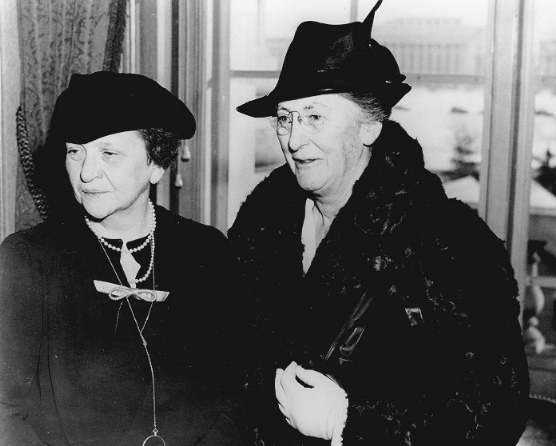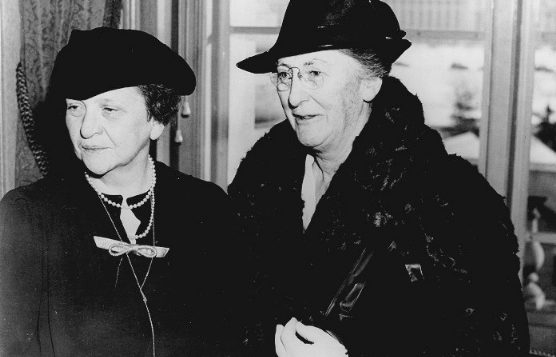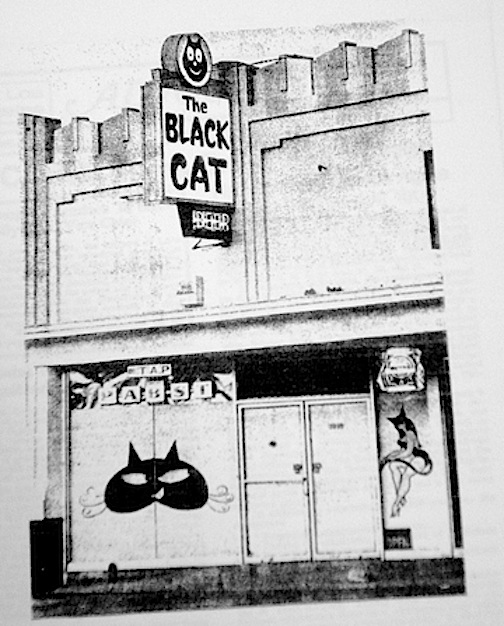WAS SHE or wasn’t she? Again, we face that vexing question regarding the lives of lesbians and gay men, in this case of Molly Dewson, who was known as “the General” in the era of the New Deal. Dewson is the subject of a book by historian Susan Ware that suddenly seems relevant, which prompted me to seek a conversation with the author of Partner and I: Molly Dewson, Feminism, and New Deal Politics (Yale 1987).
As a writer, Sapphist, feminist, and American, my moral disgust with the fallen administration of Donald Trump equaled that of Sinclair Lewis when he wrote It Can’t Happen Here (1935). But now that we have an administration that’s launching social programs reminiscent of the New Deal, it seems like a good time to return to the work of Molly Dewson and her era in American history. Dewson was the director of the Women’s

Division of the Democratic National Committee. She was among the many lesbians who followed Emily Dickinson’s advice to “Tell all the truth but tell it slant,”, i.e. encode their sexual desires. Having read Susan Ware’s book about Dewson, I was curious about her thoughts on politics then and now—what we might learn from lesbians who helped frame Franklin Delano Roosevelt’s New Deal for America during the Depression.
Dewson was a tall, athletic New England Yankee with a booming voice who wore tailored suits and sturdy low-heeled shoes and stormed the halls of Congress on behalf of women. A Wellesley graduate who was determined to change the world, she was an intelligent, assertive woman who had a 52-year relationship with a woman named Polly Porter. Their partnership was similar to those of other lesbian couples, for example, Grace Frick (We Met in Paris, by Joan Howard) and her partner, Marguerite Yourcenar. The couple was part of a circle then known as “new women” fostering social change during the New Deal. Foremost among them was Eleanor Roosevelt, who introduced some of FDR’s most sweeping social reforms in an era, like our own, that faced multiple social and political crises.
Susan Ware: Molly met Roosevelt in 1925 through the Women’s City Club. She met FDR soon after that. Eleanor and Molly were part of New York’s social reform circles, primarily populated by other like-minded women who shared a commitment to improving American citizens’ lives through social welfare legislation and political activism, mostly through the Democratic Party. Personal and political relationships overlapped in this small world. For example, Molly Dewson and her partner Polly Porter lived in the same Greenwich Village building as artist Nancy Cook and educator Marion Dickerman, who was Eleanor’s closest friend. Dewson later worked with Lorena Hickok [Eleanor Roosevelt’s longtime paramour] in Democratic women’s politics in the 1930s and early 1940s.
CL: Was Dewson part of the “new woman” generation? Did she connect with other lesbian social reformers?
SW: Dewson graduated from Wellesley College in 1897 and did consider herself part of the “new woman” generation, preparing herself for a career and showing no interest in traditional female roles like marriage and children. At Wellesley, many of her female professors lived in committed relationships with other women, a pattern that she would replicate with Polly Porter from 1910 to the end of her life.
CL: How was she able to rise to such prominence in the Democratic Party?
SW: Dewson’s rise was closely linked to her friendship with both Roosevelts. They had recruited her during the 1928 campaign and then given her increasingly important roles running the Women’s Division of the DNC by the time FDR entered the White House. Dewson was a superb political organizer and quite at home working with male politicians who respected her frankness and her ability to deliver women’s votes.
CL: Was she out as a lesbian? How did she view herself in this respect? How did this influence her work?
SW: Calling her “out” would be ahistorical. Indeed, she never used the term lesbian, and it is unclear what she thought of the term. Still, she was half of a 52-year partnership with another woman in what was the most important emotional commitment of her life. She traveled in circles in which similar partnerships or couples were commonplace and accepted, and she never felt the need to hide or apologize for her relationship with Polly. She just basically expected anyone who worked with her, male or female, to accept it.
CL: Did her lesbian identity lead her to increased sensitivity to other social issues?
SW: I see no evidence for this. This is “mainstream Molly,” after all, totally committed to working within the dominant political system. Polly was more of an out- sider, having toyed with radical politics in the 1920s, but her political views are hard to pin down. What becomes clear is how essential it was for Dewson to have a stable and committed home life. Historian Lillian Faderman reports on a poem written by one of their friends that revealed the nature of their relationship: “There was a gay woman named Polly/ Who had a firm pal yclept [Chaucerian for “named”] Molly./ They both crack their bones,/ Yet say without moans,/ ‘This staying in bed is so jolly.’”
CL: Are there lessons we can learn from her for today’s public policy and reforms?
SW: The women’s network that Molly Dewson, Frances Perkins, and Eleanor Roosevelt led in the New Deal played a significant role in establishing the foundations of the modern American welfare state. Their backgrounds and priorities as social reformers gave them the legislative and political tools to establish programs such as Social Security and then help to administer those programs.
CL: Is there anything else you’d like to add?
SW: Since writing Partner and I, I have written Beyond Suffrage, which would give your readers many more insights than I have time for in our brief interview.
Cassandra Langer is the author of Romaine Brooks: A Life (Wisconsin).






